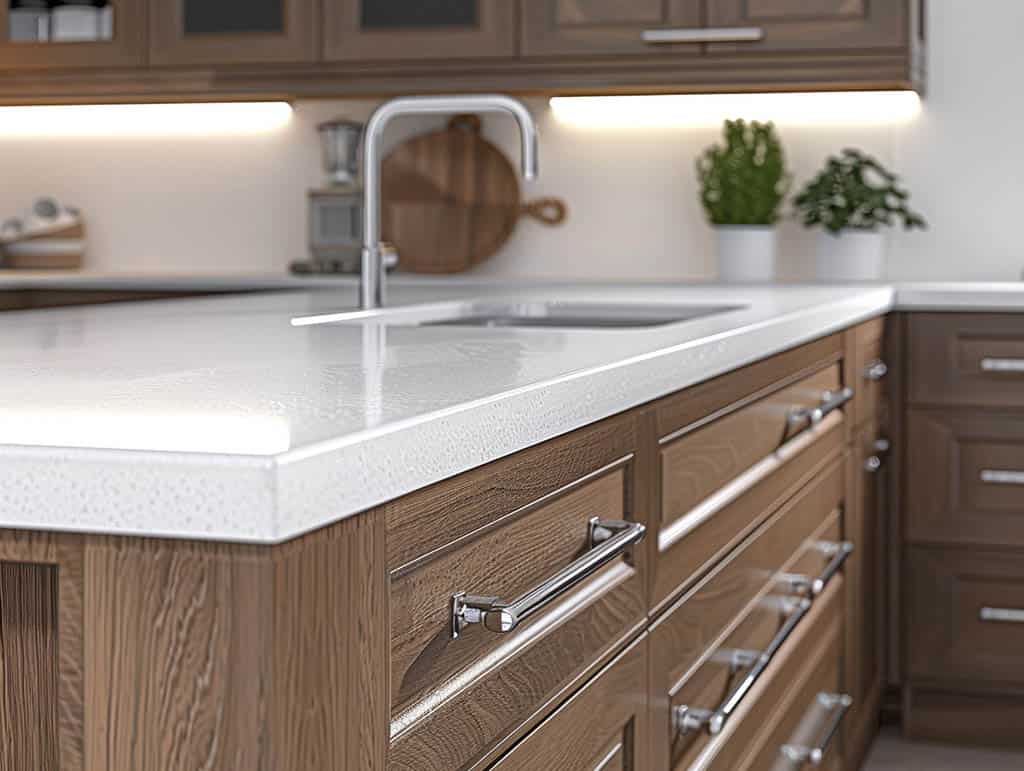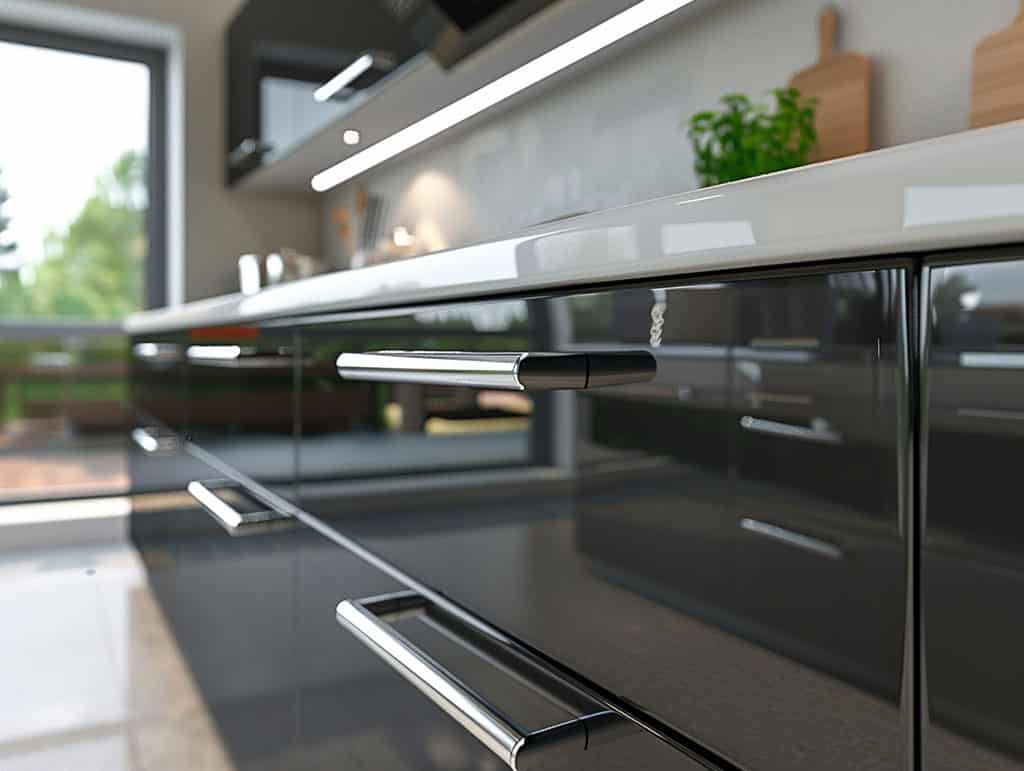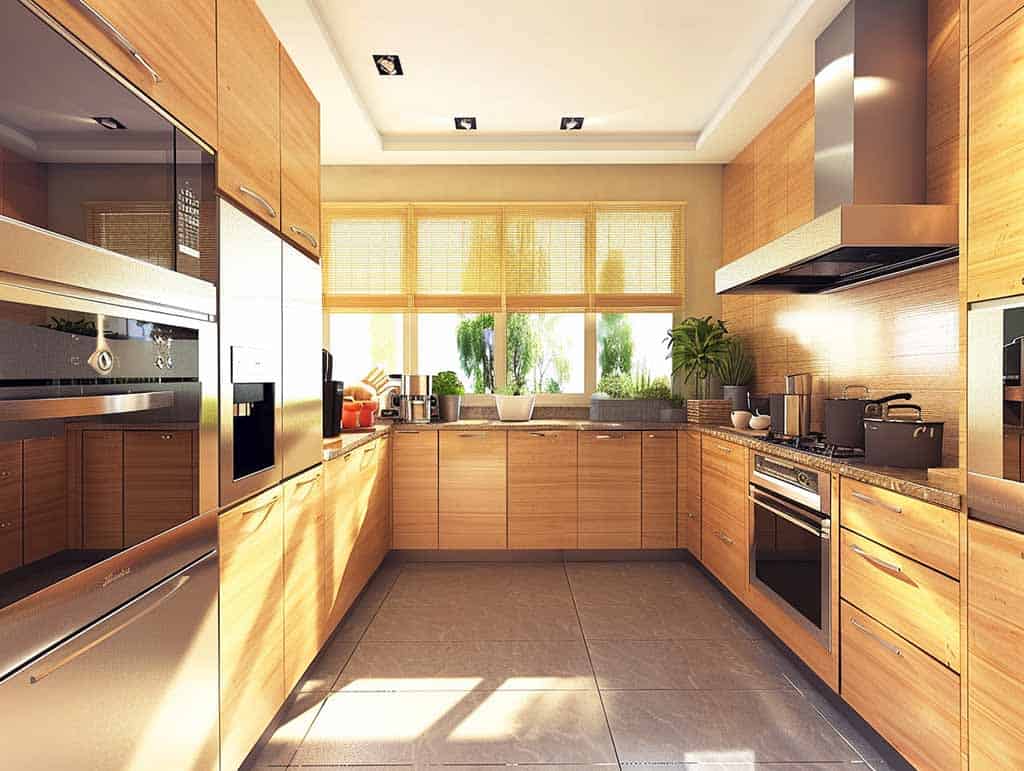Kitchen cabinets you consider for a renovation project usually consist of factory-made modules that can be arranged and designed in a variety of ways according to your needs and tastes. The core cabinet materials provide durability and structural support for units. In turn, kitchen cabinetry finishes add a final smoothness and attractive look and protect them against humidity and temperature fluctuations.

The cabinet finish is one of several aspects that make a kitchen special. If it does not have good kitchen finish materials, even well-designed cabinetry will be less appealing. And on the opposite, cupboards with a simple design but high-quality finishing are much more interesting. There are three main reasons to focus on cabinet finishes in the kitchen.
- You can maximize the use of your cabinets if you select the right finish. The modern kitchen cabinet finishes are the only way that units can be protected from the kitchen environment. Some cabinet door finishes increase the durability and resistance to water and scratches in daily usage.
- You can create a kitchen design that you love with visually stunning modern kitchen finishes. When the cabinetry finish perfectly matches the overall kitchen feel, it will improve your mood, and you’ll want to spend more time in the kitchen.
- You can give personality to your most used room in the house by exploring different finishes for kitchen cabinets. Try to feel the surfaces of the chosen finish material with your fingers. If everything feels smooth and luxurious, you’ll be happy with your kitchen.
Types of kitchen cabinet finishes
Before deciding on the kitchen cabinet finish, it is important to consider your budget, desired style, durability and maintenance requirements. To inspire you, we’ve compiled a list of the most popular kitchen cupboard door finishes along with their respective benefits and drawbacks. This table provides insight into the main characteristics of each finish, helping you choose the best kitchen cabinet finishes.
| Kitchen cupboard finishes | Durability level | Cost rate |
|---|---|---|
| Acrylic coat | high | $$$ |
| Polyurethane | high | $$$ |
| Kitchen cupboard laminate | middle | $$ |
| Veneer | middle | $$ |
| Melamine | low | $ |
| Thermofoil | low | $ |
Each finish offers its own set of advantages and disadvantages, so it’s essential to weigh these factors against your specific needs and preferences when selecting kitchen cabinet styles and finishes for your home.
Laminate kitchen cabinets
The kitchen cupboard’s laminate is composed of a substrate with high strength and an outer layer that has a design. The core layer is usually one of the engineered wood options. The thin layer of kitchen cabinet laminate, which you can see, is made from paper and resin. Thanks to its tough outer layer, laminates are highly durable. The raw edges of the laminate doors are then finished with a high-quality edge strip. Edge strips don’t always match the colour because they are often made of a different material.
Laminate kitchen cabinet material offers great durability for a low price. It comes in many different patterns, colours and designs. Laminate for kitchen cupboards is available in a variety of forms, including textured, matte, high-gloss, and semi-gloss. Because of low maintenance, kitchen laminate cabinets can be an excellent option for busy families. They are stain-resistant and don’t require scrubbing or deep cleaning. All you need is a simple multi-purpose cleaner to clean laminate kitchen cabinet doors.
The quality of kitchen cabinet laminate varies, even though it is a durable and low-maintenance product. While more affordable laminate options will obviously be budget-friendly (such as kitchen kickboard laminate, which still has water-resistant properties but is not so attractive as it is little noticeable); there are laminate kitchen cupboard doors with higher quality that have longer lives and better finishes.
While timber laminate kitchen cupboards are resistant to scratches and stains, it is still possible for your modules to be damaged. Repairing laminate peeling off kitchen cabinets is extremely difficult, and sometimes impossible. Still, there is always the option to replace laminate kitchen cabinet doors if they lose their appearance or go out of trend.
Laminate kitchen designs
Laminate finish for the kitchen offers a wide range of design options. There are likely kitchen laminate colours for any cabinet style you can imagine. They suit best for modern laminate kitchen cabinets. However, they also come in textured finishes if you want a wood grain or bamboo look. Wood laminate for kitchen cabinets is actually more durable than solid wood. At least it is more scratch-resistant and is also less likely to warp or rot.
A plastic laminate for kitchen cabinets can have a shiny or matte surface. For the small kitchen, reflecting light can make the room appear brighter and more spacious. White laminate kitchen cabinets complement various design styles, from contemporary to minimalist. Additionally, gloss laminate kitchen cabinets offer a sleek aesthetic to any kitchen space. And, an easy-to-clean surface makes them an excellent choice for high-traffic areas like the kitchen.
How to paint laminate kitchen cabinets?
Your white laminate kitchen is not so white after years of usage or cabinet colours are looking dull? Even though laminate doors can be durable at a certain level, they are still subject to wear and tear over time. If they are in good shape, painting laminate kitchen cupboards can help you save money by avoiding costly replacements.
It is possible to paint laminate kitchen cabinets, even though it’s not the best surface for painting. The smoothness of laminate surfaces makes it difficult to hold paint. Surfaces that are laminated need to give a rougher texture by sanding. Because the layer of laminate on kitchen cabinet doors can be thin, it’s important to sand them cautiously.
Even after sanding, you need to use a primer that is made for painting kitchen laminate cabinets. Further is as simple to paint as any other project. The right job can make a huge difference to the appearance of laminate colours for the kitchen without spending a lot of money.

Polyurethane kitchen cabinets
Polyurethane (PU) is a type of paint finish for kitchen cabinets. It features hard-wearing qualities and is available in an array of colours. Once the substrate has cut to a final size, it will be sealed, and coated with polyester and multiple-coated polyurethane on all sides. Polyurethane kitchen door edges can be softer on the touch and rounded because of the process. To achieve a high-quality kitchen cabinet polyurethane finish, the door is sanded repeatedly between each layer applied.
On doors, drawers and panels, polyurethane kitchen finishes are applied to moisture-resistant MDF. Polyurethane for kitchen cabinets will suit any design style, whether you prefer a modern or a traditional look. You can use polyurethane paint on cabinet doors that are profile routered. They do not have to be flat or plain.
The finish options include satin, matt and high gloss. Each type of polyurethane cabinet finish offers unique properties that allow homeowners to select the one that best meets their style preferences and practical requirements:
- Gloss finishes provide polyurethane kitchen cupboards with an ultra-modern appearance, reflecting light to create a bright and contemporary ambience in the room. They look sleek and striking, being ideal for modern or minimalist design aesthetics. Still, glossy surfaces may require more frequent cleaning.
- Hand-painted finishes add a personal and unique flair to the kitchen. Customization in polyurethane kitchen cabinets colours and design options allows individuals to make a choice to their personal taste. Polyurethane hand-painted kitchen cabinets tend to last longer than other painting methods while creating long-term quality appeal in surfaces.
- Polyurethane satin finish for kitchen cabinets provides a timeless and classic aesthetic, offering the ideal balance between glossy and matte extremes. Their subtle sheen adds depth while still remaining relatively matte in appearance, making this finishing type the best polyurethane for kitchen cabinets.
Polyurethane kitchen cabinets’ price is usually much higher due to its durability, resistance to water, scratches and chips and the time that it takes to make. However, it has a more appealing polyurethane finish for kitchen cabinets, as it is able to achieve a more unique and bespoke look.
Melamine kitchen cabinets
Kitchen cabinet melamine is widely used in cabinetry manufacture, bathroom vanities and other furniture. The word “melamine” is the common term for particle board covered with a very thin layer of plastic. Melamine kitchen cupboards are a good choice for the environmentally-conscious homeowner. It is made with a wood substrate that is usually sourced from sustainable forests and recycled.
Modern melamine kitchen cabinets come in many different styles, such as framed or frameless, so that you can find the right choice for your house. Kitchen cabinets from melamine are easy to clean and require less upkeep than other finishing options. Use a light-duty scrubbing cloth and mild dish detergent to clean.
As a melamine board for a kitchen cabinet is made from compressed wood, any cracks or dents will be visible on the surface. Melamine finish for kitchen cabinets can be splintered if you don’t use the right tools for installation. The material also absorbs humidity more quickly than most others.A kitchen cabinet melamine board suffers more damage when water contacts its surface. After absorbing liquid it can expand and become less strong.
How to update melamine kitchen cabinets?
Melamine kitchen cabinet material is covered with a type of plastic that can come away from the surface it’s attached to over time. You can use an instant adhesive to reattach the kitchen melamine sheets if it has only become loose in certain areas. If the melamine cabinets in the kitchen have larger loose areas, you’ll need to repaint them.
However, the process differs from painting wooden units. The peeling parts of the kitchen melamine cabinets need to be sanded in order to remove any loose material and to minimize the transition between the bare underlay and the finished surface. Vacuum all dust from sanding and wipe the cabinet clean with a moist cloth. Once the melamine kitchen cabinet is cleaned, you can apply one or several coats of primer. Spray primers are the best option for melamine kitchen doors because of their smooth surface. Apply a few coats of topcoat paint in the same way. This ensures that your melamine kitchen set will look professional and last a long time.
Kitchen veneer cabinets
Kitchen cabinets, often use veneers made from thin sheets of real wood to give them a natural appearance. It is commonly used on both, veneer kitchen carcasses and fronts. Wood veneer kitchen cabinets give you the best of both worlds: grains of real wood and modern finish functionality.
Timber veneer kitchen cabinets are versatile, allowing designers to create custom and unique pieces. There are not just oak veneer kitchen cabinets available, but because of the less wood material used, it can be walnut veneer kitchen cabinets or other exotic hardwoods at a quite affordable price.
Still, with long exposure, water or excessive humidity can damage kitchen cabinet veneer sheets. If the veneer gets wet, dry it with a rag. Also, keep cabinets away from windows to avoid sun rays. Veneer panels for kitchen cabinets can fade or yellow if exposed to direct sunlight. It is best to use blinds or keep cabinets away.
Kitchen cabinets veneer vs solid wood
Wood veneer for kitchen cabinets have become popular because they can imitate the feel of real wood for a fraction of the price. Kitchen cupboard veneer is more stable and less prone to cracking or warping than solid hardwood. This is because the kitchen timber veneer thin layer is not affected by temperature and humidity changes, still protecting substrate material from the kitchen environment.
To protect the veneer itself, various wood kitchen cabinet finishes can be applied. Wood is a core material, so finishes for wood are mostly related to different types of stains and paints. You may also cover wood with glaze, lacquer, wax or transparent top coat. Kitchen cabinet wood veneer’s natural beauty can be as well enhanced and protected with stains, oil, or varnish. With extremely careful sanding, modern veneer kitchen cabinets can be refinished to maintain their look over time.

Thermofoil kitchen cabinets
A thin vinyl film is applied with heat and pressure to MDF or particle board panels to get the thermofoil. This technology makes them perfect for humid environments like kitchens and bathrooms. Thermofoil kitchen cabinet doors are a popular choice for homeowners seeking a budget-friendly yet stylish option for their kitchen refacing. Thermofoil cabinets feature seamless surfaces resembling any wood grains, patterns or solid colours. Additionally, they can be easily maintained using soap and water for cleaning.
As time progresses, thermofoil cabinets become apparent because of their deficiencies. While initially offering vibrant colours and sleek finishes, over time their durability declines. Their vibrant hues begin to fade as cleanings cause discolourations to the material itself and its aesthetics dwindle further. Furthermore, unlike other materials, thermofoil cannot be repaired once damaged leaving homeowners no way of restoring its appearance back into place.
Acrylic finish coating
If you’re looking for a high-gloss kitchen cabinet material acrylic is a way to go. With a non-toxic acrylic finish on your cabinets, you can achieve a stunning mirror-like appearance. It is durable, moisture and scratch-resistant, does not fade, delaminate or discolour after several years of use, and is available in many vibrant colours. Even the most glossy laminates cannot match the shine and sophisticated appearance that an acrylic coating can bring to your cabinets.
But acrylic high-end finishes also have their cons. Although acrylic cabinets are easily cleaned, they must be cleaned regularly because dirt, grease and fingerprints as well as other stains/marks can be seen on them.
You should also consider that high-end aesthetics will cost more. Compared to laminates, the acrylic coating is more expensive. Fully acrylic-finished kitchens are often found in luxury, where a striking appearance is the primary criterion before a budget.
FAQ
Different kitchen cabinet finishes offer varying levels of durability, aesthetic appeal, and cost. Acrylic and polyurethane kitchens offer durability with their sleek appearance but come at a higher cost. Laminate and veneer offer affordability while still being versatile in design options. Textured melamine kitchen cabinets are budget-friendly but may be susceptible to damage from moisture.
Can you paint kitchen laminate cabinets?
Painting your laminate kitchen cabinets to update their look can be accomplished. However, proper surface preparation such as sanding for better paint adhesion will help you to achieve the best result. Apply multiple coats of professional-grade primer designed specifically for laminate surfaces followed by multiple coats of paint for impressive painted laminate kitchen cabinets.
Is melamine good for kitchen cabinets?
Melamine kitchen cupboards are an economical and long-term investment due to their durability. The melamine layer offers many design choices and easy maintenance, making it suitable for busy households. Unfortunately, melamine may become damaged from moisture exposure and impacts, so regular upkeep must be performed in order to extend its lifespan.
Would I be able to refinish my kitchen cabinets in the future?
Paint finishes for the kitchen can often be easily refinished to achieve desired aesthetic changes. For instance, polyurethane finishes applied to multiple layers can often be sanded down and refinished successfully. While this approach rarely works with laminate or veneer surfaces. Refinishing depends on factors like the current finish, condition of cabinets and desired outcome.
